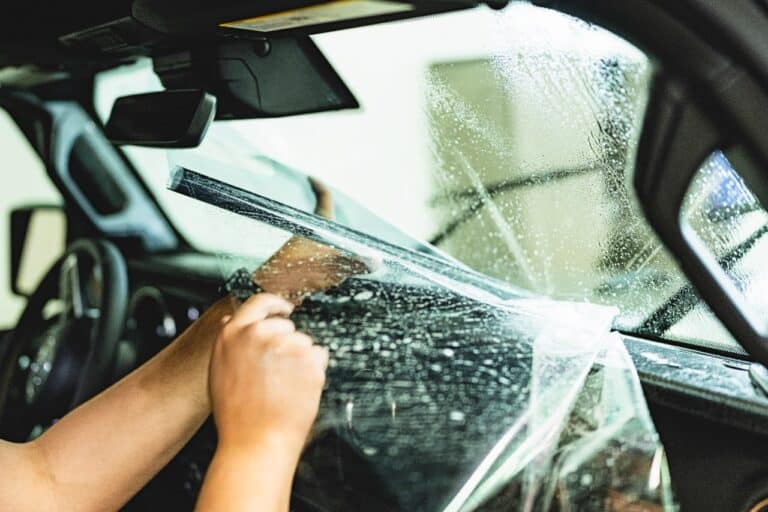
Most of us spend considerable time inside our cars during the work week. That amount of time adds up when you include weekends, road trips, running errands, and other occasions requiring you to drive. Spending time behind the wheel means being exposed to the sun’s UVA and UVB rays through a vehicle’s windows, including the windshield.
While the factory windshield provides some UV protection within its laminated construction, front side windows usually carry a lighter percentage of tint than the rear and back windows. There are significant benefits to having a windshield treated with XPEL window film, but it’s essential to understand what kind of sun protection your vehicle’s windshield already provides. And how PRIME XR PLUS window film can enhance the quality of a car’s interior while helping to improve its overall efficiency.

We’ve all had to step into a car or truck after it’s been sitting in a parking lot all day under the sun. Feeling the wave of furnace-like heat hit you in the face the moment you open the door. Being careful not to touch any exposed metal ready to burn the skin. Rushing to turn down the windows and crank up the AC to get the heat out of the car. Yet, still having to wait a considerable amount of time before you can feel comfortable again. A solution to this help you beat the Texas heat is having XPEL PRIME XR PLUS window film on your vehicle’s windshield.
Besides a panoramic sunroof, the windshield is typically the largest window in a vehicle that is not tinted. Meaning it lets in the most amount of heat. PRIME XR PLUS offers an optically clear film to deflect up to 96% of infrared heat. Reducing the amount of infrared heat helps your vehicle’s interior stay cooler during high temperatures. It also makes it easier for the air conditioning system to cool down the interior faster.
Your vehicle’s air conditioning system will also not need to work as hard to maintain the desired temperature as the outside heat coming in is reduced thanks to the properties in XPEL window film.

Besides a panoramic sunroof, the windshield is typically the largest window in a vehicle that is not tinted. Meaning it lets in the most amount of heat. PRIME XR PLUS offers an optically clear film to deflect up to 96% of infrared heat. Reducing the amount of infrared heat helps your vehicle’s interior stay cooler during high temperatures. It also makes it easier for the air conditioning system to cool down the interior faster.
Your vehicle’s air conditioning system will also not need to work as hard to maintain the desired temperature as the outside heat coming in is reduced thanks to the properties in XPEL window film.

Two kinds of glass are used in vehicles for specific purposes and unique construction. Tempered glass is created by heating a piece of glass and then cooling it down rapidly. This process gives the glass a better resistance to impacts and is commonly featured inside and rear windows for its durability. Anyone who’s ever tried to punch through a car’s side window like on TV and in movies, we’ll tell you how strong tempered glass can be.
Windshields use laminated glass. This method involves a layered process of two pieces of glass with a transparent plastic film sandwiched in the middle. In the event of an accident, the plastic film holds the shattered glass together to prevent shards of glass from hitting the front passengers.
This safety film also protects against UVA and UVB rays. More significantly, UVB rays, which is why you can drive all day with the sun beating down on your face, hands, and arms without getting burned, but UVA rays can still penetrate through. UVA rays are the ones that damage your skin and increase the risk of developing skin cancer.

When you drive past a car dealership, you’ll notice that modern SUVs, trucks, and sedans come from the factory with dark rear and back windows. However, front-side windows, sunroofs, and windshields are often left untreated.
According to The Skin Cancer Foundation, ultraviolet rays can very much penetrate through your car’s glass windows, increasing your risk of skin damage and skin cancer. Particularly the left side of our bodies, which is in constant exposure to the sun through side windows with no UV protection. Having quality window film on your car is a matter of safety and improving privacy and interior comfort.
Technology in window film for cars has advanced milestones in recent years. The old “darker is better” way of thinking is no longer relevant regarding privacy. It used to be that if you wanted privacy from the outside world, you needed “limo tint,” which came with the drawback of being unable to see at night and the possible legal trouble of having dark window tint depending on state law.
With PRIME XR PLUS window film, you get performance without compromise. You can have the aesthetic and privacy of dark window film without affecting outward visibility. Plus, the added peace of mind that whether you get 5 percent or 70 percent tint on your car, its UV and infrared heat-blocking performance remains at an industry-leading standard.
It varies from state to state. Some states only allow the top five inches of a windshield. According to the Federal Motor Carrier Safety Administration, the general rule is tint on a windshield is allowed, under the condition that at least 70 percent of outdoor light enters the vehicle. However, XPEL’s windshield film is optically clear to meet any state law concerning window film application on vehicle windshields.